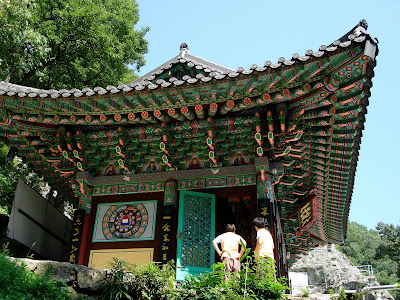The weekend program in which we participated focused on meditation, yoga, temple food and seonmudo (선무도 - 禪武道), a Korean seon (zen) martial art. It also included tea ceremonies, hiking and archery.
 One train station closer to Nirvana
One train station closer to Nirvana Front gate of Golgulsa Temple
Front gate of Golgulsa Temple One of the dormitories
One of the dormitories We were woken up at 4 AM to meditate here until the sun rose.
We were woken up at 4 AM to meditate here until the sun rose. Seonmudo center
Seonmudo center Inside
Inside Meditation room
Meditation room Neat dancheong
Neat dancheong Lots of gold
Lots of gold Buddha carved into the mountain peak
Buddha carved into the mountain peakI was surprised by the number of foreigners at the temple-stay program; of the 30-some weekend participants, over half were European. The largest group was from Germany—there were more German speakers than native English speakers—and there were also a handful of Frenchmen and Americans.
I think for many of them, as for me, the temple-stay was not about anything religious—we couldn't understand most of the esoteric explanations anyway—as much as it was about relaxation, vigorous exercise, reflection and interest in traditional Korean culture.
Did I mention that our instructor was a friendly Norwegian fellow who spoke Korean more fluently than I do?
